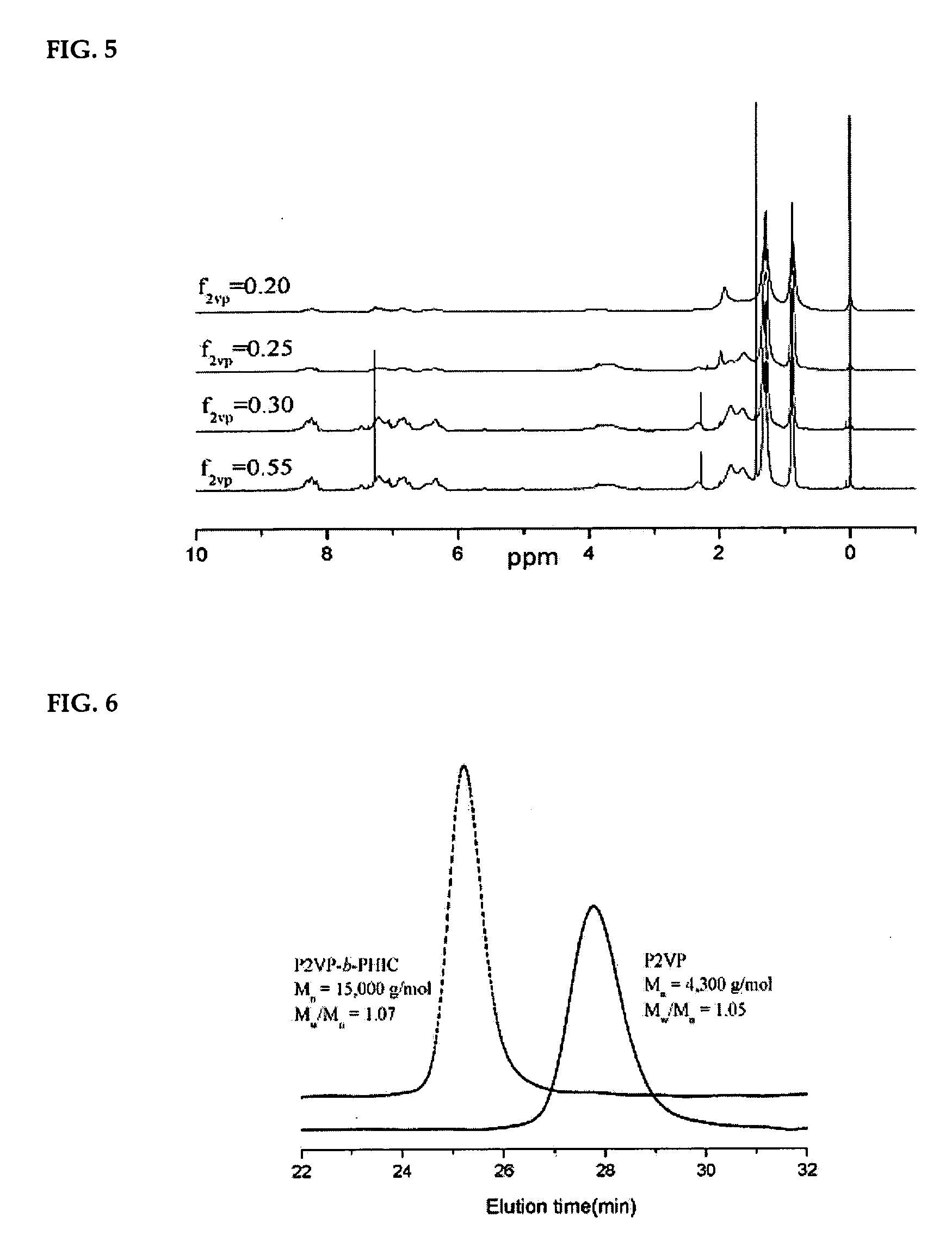Poly(2-vinylpyridine)-b-poly(n-hexylisocyanate) amphiphilic coil-rod block copolymer and polymerization method thereof
a technology of polyisocyanate and coil rod, which is applied in the direction of excavation, construction, foundation engineering, etc., can solve the problems of lithium chloride less soluble in solvent and limited, difficult to control molecular weight, and limited solvent soluble lithium chlorid
- Summary
- Abstract
- Description
- Claims
- Application Information
AI Technical Summary
Problems solved by technology
Method used
Image
Examples
example 1
Homopolymerization of 2-vinylpyridine
[0035] 2-Vinylpyridine (2VP) was used as monomer. Polymerization was performed at −78° C. and high vacuum (10−6 torr). Tetrahydrofuran was used as solvent. Polymerization was performed for 10 to 45 minutes. The reaction temperature of −78° C. was maintained by adding dry ice in an acetone thermostatic bath. The temperature of the bath was measured with a low temperature thermometer. Potassium diphenylmethane (K-DPM), an initiator, was prepared from the reaction of a potassium-naphthalene (K-NaPh) ion solution and diphenylmethane. The initiator was promptly isolated in a glass ampoule after being diluted to an adequate concentration by passing through a distribution unit connected to a vacuum line and then kept in a low temperature refrigerator.
[0036] Polymerization was performed using the homopolymer polymerization apparatus illustrated in FIG. 2. The polymerization apparatus comprising glass ampoules containing the purified initiator (K-DPM), ...
example 2
Homopolymerization of n-hexylisocyanate
[0040] To find an effective reaction termination condition at the active terminal of the living chain during termination of polyisocyanate polymerization, methanol (a reaction terminator), a mixed solution of methanol and hydrochloric acid (1:0.01 v / v) and a mixed solution of methanol and acetic acid (1:0.01 v / v) was used, respectively.
[0041] Polymerization was performed using the homopolymer polymerization apparatus illustrated in FIG. 2. The polymerization apparatus comprising glass ampoules containing an initiator, a monomer, an additive, a reaction terminator and a cleansing solution was connected to a vacuum line, so that its inside is maintained at high vacuum (10−6 torr) and under nitrogen atmosphere, and then sealed off from the vacuum line. After the inside of the apparatus had been cleansed with the cleansing solution, the apparatus was installed in a thermostatic bath containing methanol of −98° C. which had been frozen by liquid n...
example 3
Block Copolymerization of 2-vinylpyridine and n-hexylisocyanate
[0044] 2-Vinylpyridine (2VP) was used as the first monomer. Polymerization of 2-vinylpyridine was performed at −78° C. and high vacuum (10−6 torr) using tetrahydrofuran as solvent. Polymerization was performed for 30 minutes. The reaction temperature of −78° C. was maintained by adding dry ice to an acetone thermostatic bath. The temperature of the thermostatic bath was measured using a low temperature thermometer.
[0045] Polymerization was performed using the block copolymerization apparatus illustrated in FIG. 1. The polymerization apparatus comprising glass ampoules containing a purified initiator (K-DPM), monomers (2-vinylpyridine and n-hexylisocyanate), an additive (sodium tetraphenylborate, NaBPh4), a reaction terminator (mixed solution of methanol and acetic acid) and a cleansing solution was connected to a vacuum line, so that its inside is maintained at high vacuum and under nitrogen atmosphere, and then sealed...
PUM
| Property | Measurement | Unit |
|---|---|---|
| molecular weight distribution | aaaaa | aaaaa |
| molar ratio | aaaaa | aaaaa |
| temperature | aaaaa | aaaaa |
Abstract
Description
Claims
Application Information
 Login to View More
Login to View More - R&D
- Intellectual Property
- Life Sciences
- Materials
- Tech Scout
- Unparalleled Data Quality
- Higher Quality Content
- 60% Fewer Hallucinations
Browse by: Latest US Patents, China's latest patents, Technical Efficacy Thesaurus, Application Domain, Technology Topic, Popular Technical Reports.
© 2025 PatSnap. All rights reserved.Legal|Privacy policy|Modern Slavery Act Transparency Statement|Sitemap|About US| Contact US: help@patsnap.com



